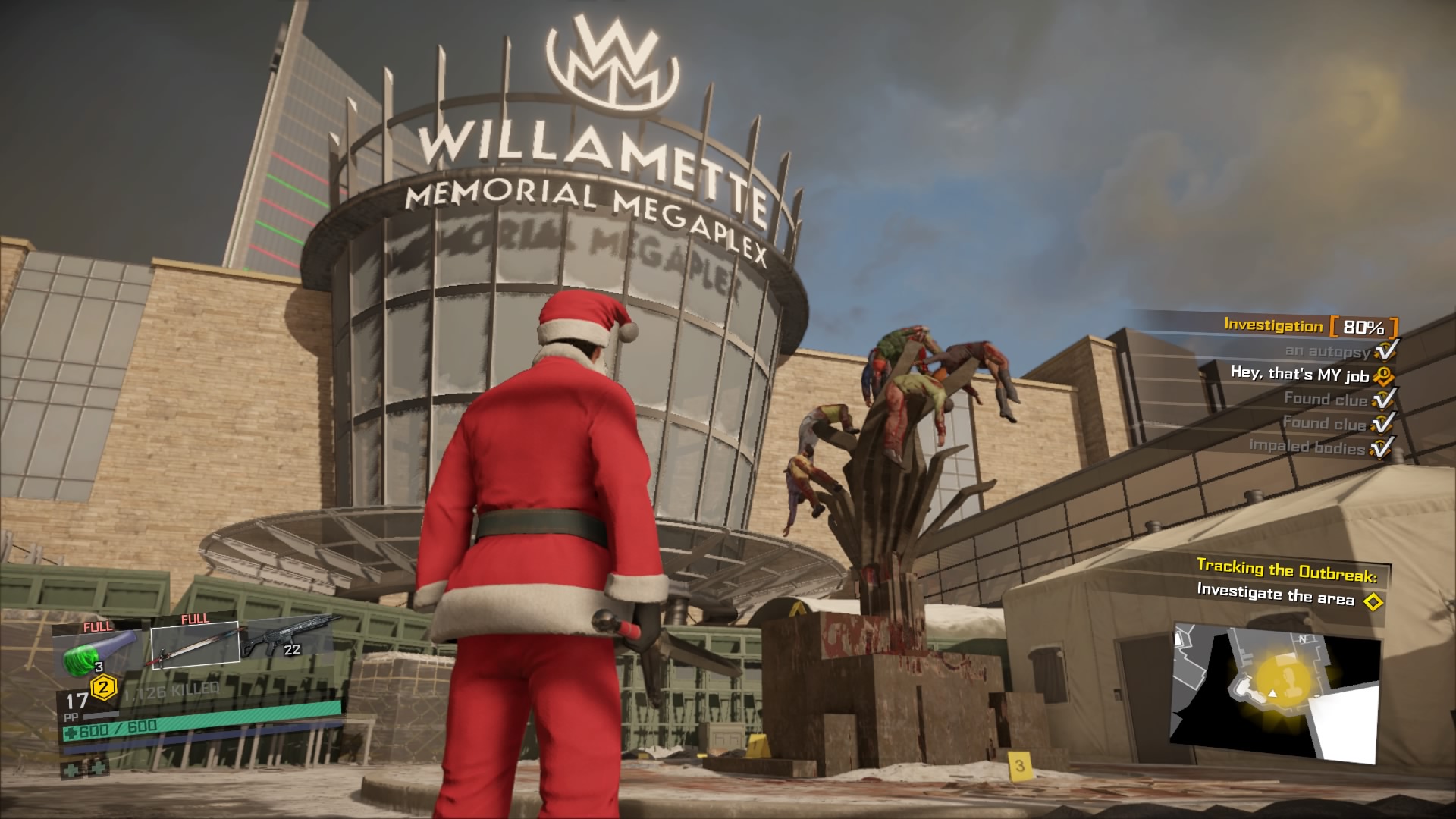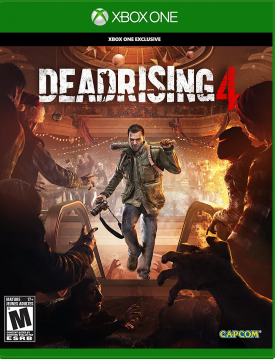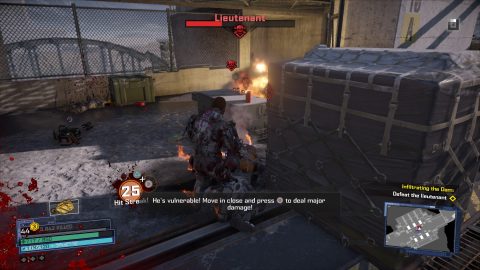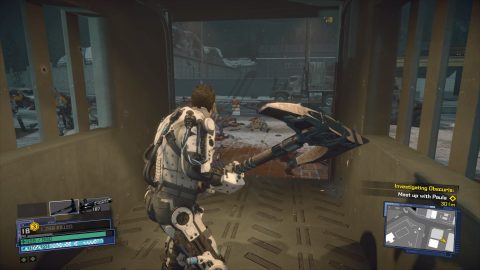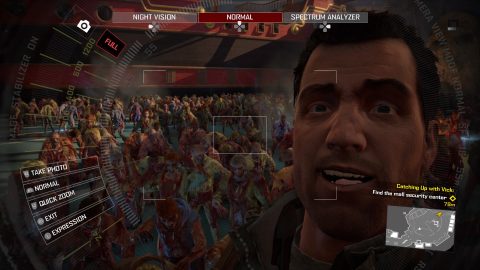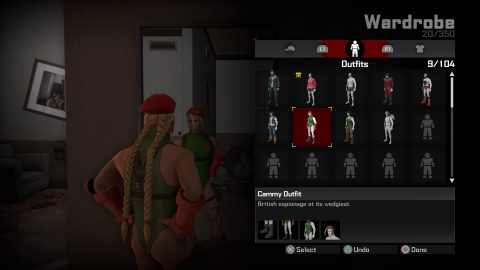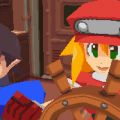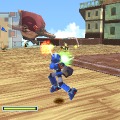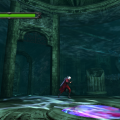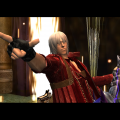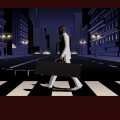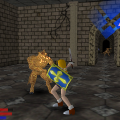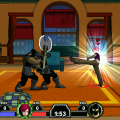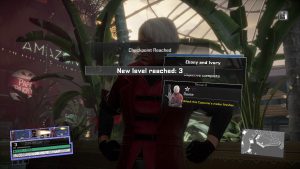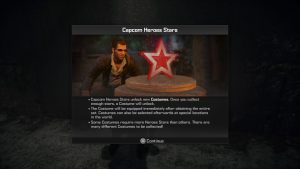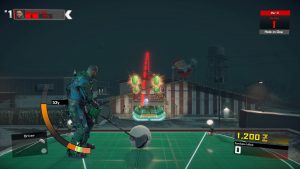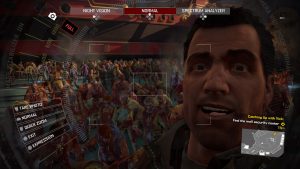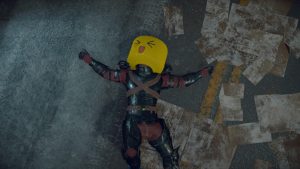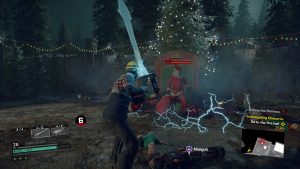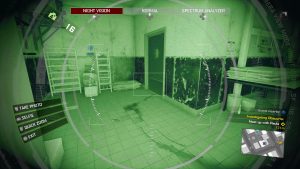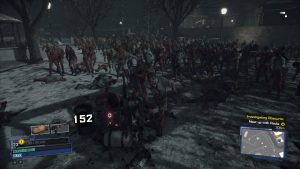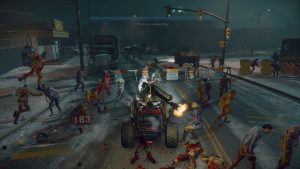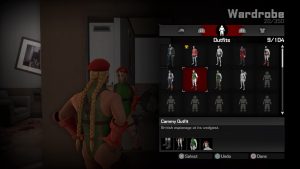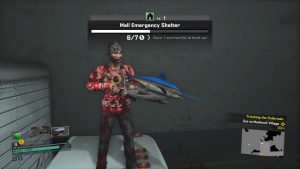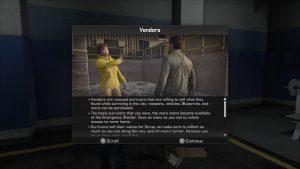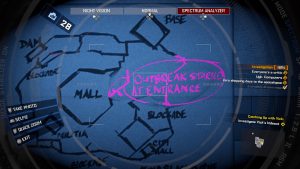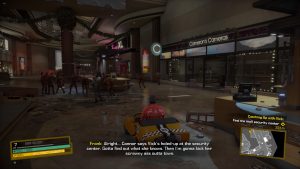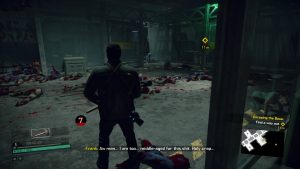- Dead Rising
- Dead Rising 2
- Dead Rising 3
- Dead Rising 4
The emergent magic is gone, and these aren’t the characters or the kind of Dead Rising game you remember, but…zombies at Christmas is its own thing.
Dead Rising 4 was released December 6th 2016 on Windows and Xbox (with a Steam Release coming in March 2017, and a PS4 with all the DLC titled Dead Rising 4: Frank’s Big Package, on December 5th 2017), and was meant to be a return to form for the franchise. The heavily Christmas themed game would bring back Frank West, the original’s protagonist, and take him back to the shopping mall in Willamette Colorado where the zombie outbreaks began. However, neither the fan service or window dressing would be enough to salvage what’s ultimately the thinnest, least-like Dead Rising game in the series.
While the watering down and diverging from of the original’s core experience had begun showing with Dead Rising 3’s stretched out in game timer (which felt like a compromise due to map size more than anything), its overly large world map filled with icons and repetitive tasks (which made moving through the world more of a rote requirement than exploration for fun or survive), and more empowered player character (with its super combo weapons, experience trees, and posse of survivors), Dead Rising 4 would see the removal of the in-game timer entirely (although it returned for one episode of DLC), and, while the photography system from the original returns (with the added ability to have Frank join the shot to take selfies), the game’s overall direction has devolved further into a linear, action-horror slog of shooting galleries, but now with forced photography puzzles that desperately try to mirror the detective sections of Rocksteady’s Batman: Arkham games.
The problem with every additional Dead Rising release has been in the push and pull between supporting its serious survival horror side (and the punishing difficulty associated with the first game) and its zanier, action-comedy leanings. The original forged a strong balance between the two by being situationally silly (in how a skateboard could be useful in traversing a mall, and a big umbrella could functionally push away zombies for crowd control), yet serious in tone and what it demanded of players with its difficulty. It found further grounding by supporting and giving players almost two entirely different ways to “play”. Its players could have fun doing nothing but exploring and playing around in the sandbox, or experience a challenge when trying to “survive” the game’s main story. The game was pick up and play fun for casual players, and rewarding for those willing to contend with its disempowering design philosophies.
What Dead Rising 4 is, however, would make it the most poorly reviewed Dead Rising game of the series, which is always a disappointing way to see a franchise go out for longtime fans, but even more so when, comparatively speaking, 2016 alone had already seen wildly inventive and successful relaunches of old series, like with IO Interactive’s Hitman (which leaned into its replayability by building elaborate sandboxes where, like the original Dead Rising pitch, everything was a weapon) and id’s Doom (which leaned into its linearity by making rooms fast, explosive, and responsive action puzzles). Dead Rising 4, on the other hand, was sticking to its most basic, “beat-em-up in a slightly open world” roots, and ended up seeing most of its core experience carved away and severely hamstrung by a troubled development process (but more on that later).
Taking place 16 years after the events in the first game, Dead Rising 4 sees an aging Frank West working as a college professor, and having nightmares about the horrors he’s experienced (albeit dressed up in Christmas clothes). One of his students tricks him into breaking into a government facility with promises of mini-golf, they learn some evil zombie research is afoot, get discovered while escaping, and Frank is then labeled as a fugitive. Some time goes by, and Frank is asked to help investigate a zombie outbreak that happened several months earlier back in Willamette, and things continue to spiral disastrously downward from there.
And while the plot beats can feel overly rote to Dead Rising fans, the game’s tone has shifted wildly from past games to being incredibly jokey, with comedic cutaways where someone says “I’m never doing that”, before cutting to them doing it. Frank thinks he’s being stealthy, then we cut to a villain seeing him sticking out like a sore thumb. In short, the writing is painfully bad, characters are bland and forgettable, and events are familiar and tedious.
There’s a new strain of the virus that’s more dangerous and unpredictable than before, somehow, shadowy mega corporations are, surprise, doing something they shouldn’t to make money, and the character development amounts to everyone telling Frank how bad of a person he is while he also fails his way towards having done the “right” thing. There’s no exploration of Frank’s trauma, big choices for our characters, or a deeper depth to the outbreak and the parties involved, or any reflections on the events of the series as a whole. No, just another “escape the outbreak with evidence” story that’s also trying to explore if Frank cares more about fame than the people and events going on around him, with an ending so frustrating the DLC tries to re-end things a little better. It’s as predictable and one note as it sounds, with the Frank West character feeling more like a textbook case of flanderization than a wizened version of his old self.
Combat is still a relatively shallow mix of light and heavy attacks, with a combo meter rewarding players with devastating super attacks after a certain number of zombie kills. Inventory has been streamlined even further, with all items fitting into their own respective inventory lots (melee weapons, ranged weapons, throwable weapons, and health items), which means there’s no real survivors dread of having to choose between one more weapon or one more health item in an almost full inventory. Shooting feels a little more competent than in games past because of these and other small quality of life fixes, but because of regenerating health, easy to find health items, and easier to make combo weapons, the game isn’t really difficult or challenging enough for it to matter.
This makes the inclusion of battle armor style “Exo-Suits” feel even more superfluous, but, in the end they don’t amount to much more than wearable combo vehicles without wheels. They can be found around town occasionally, and further power upped by finding their own kinds of weapons or power ups to perform wild ice, wind, or electric attacks and the like, but they’re so few and far between, are only ever found in a few unchanging places, and because the suits “fall off” after a certain amount of time, it makes them useless outside a short range from where you find them. What makes them even more aggravating is how wearing one prevents players from using any of the combo weapons they might have crafted for tough encounters. Some sections of the game force you into the suit, and then undermine and explain away the timer by saying there’s equipment in the area which “boosts” the suits charge so it won’t fall off, but all this means is you won’t be able to take the suit off even if you want to.
There’s enough from the old games to feel a bit like a Dead Rising game, but a big problem with the game is just how much lands flat, and how much content feels like forced fluff and filler. Players can still track down new blueprints to make more combo weapons, find more outfits to play dress up with Frank, collect mini-stories in the form of newspapers, phone messages, and audio logs, and there’s small events and quests around the map to reward players with plenty of experience. There’s also a large skill tree and the level cap has been doubled to 100, but there’s so many useless abilities and level requirements that keep you from getting too strong in any one direction too quickly that it ruins a lot of the fun. There are vendors in safe houses now, but some items are locked behind rescued survivor requirements, and shelters need to be cleared before rescued survivors even have somewhere to go, so, while there’s a fair amount stuffed into the open world map, so many activities feel like the same, repetitive side mission or overly constrained busy work. Players are tasked with killing X amount of enemies in a given area over and over, or asked to drive two laps around the go-kart track in a tiny car in an attempts to recapture the manic, silly magic from the earlier games, and that’s about it.
While being unabashedly more about shallow action and simple fun this time around, there are still other changes that have cascading effects on difficulty and engagement, and it feels like every attempt to fix one thing causes a different kind of problem somewhere else. Small things, like health being in points instead of a set number squares make the danger feel less apparent. Players can also perform a quick-time-event style button press to counter a zombie grab, but the trade off is in automatically losing health points from small brushes against crowds of zombies. In the previous games, there was a weight and heaviness to every lunge and grab that stopped you dead in your tracks, surrounded you with more zombies, and robbed you of your health in large chunks. Now, taking light, constant damage doesn’t feel as impactful, and the hardest difficulties attempt to inject some more tension into combat do nothing but turn zombies into bullet sponges that do devastating amounts of unavoidable chip damage, and make the waves of gun toting soldiers with auto-aim frustratingly difficult to contend with unless you have more guns than they do.
On the whole, this is a different, and much more linear and simpler, third person action game experience than other Dead Rising games, but also a less demanding, deep, fun, and surprising one. One of the biggest disappointments comes from the watered down Psychopath encounters (or, mini-boss fights that used to spice up the combat and side areas with dangerous, memorable moments) which are now called “Maniacs”, and no longer come accompanied with cutscenes to give its characters more backstory and build up. There’s still a bit of fanfare and variety injected into these fights, but mostly amount to killing a few waves of mobs before an anticlimactic showdown, with no real payoff.
Perhaps the biggest problem is the game’s lack of an in-game timer, which, as well as being the survivalist backbone to the Dead Rising formula, speaks to the lack of content, variety, and stakes plaguing the rest of the game. This has the small, knock-on affect of eliminating the day and night cycle’s tougher to kill night-zombies that used to make exploring at night more dangerous and tense, but the lack of a timer also makes the game’s main story lose a lot of its urgency. Instead of worrying and weighing the option to explore and finish side missions against the main story’s quest line, now we’re simply running from objective marker to objective marker, killing enemies in the area, and watching a cutscene. Being able to run around as much as you like (once the world opens up) might feel more freeing at first, but a lack of “time”, coupled with locked areas and walls abound, give the world a bit of an immersion-breaking stillness, and even if this game’s scripted, linear design can approximate the vertical slice of moments from earlier Dead Rising games, the forced way in which you’re hand fed them can’t compare to the emergent and surprising way the earlier games felt.
There’s still some fun to be had from the game if not taken too seriously though, and fans of the series might have some good memories, enjoy the new combo weapons, and get to scratch that mindless collectathon itch. While a lot of the environments feel generic and less interesting than past games, the map is less sprawling and more manageable than Dead Rising 3’s, and there’s still a commitment to wacky set pieces with silly, accompanying enemy design. There’s also something to be said for a game that really tries to go full Christmas, so playing it around the holidays can be its own kind of self-indulgent treat. A lot of the lighting is dark, warm, and colorful, and while the music isn’t filled with familiar classics, there’s plenty of wintry instrumentations with jingle bells and holiday feels.
The bad of it all will come in waves though, with plenty of bugs (graphical glitches, slow downs, and crashes on pc), bad writing, repetitive tasks, shallow gameplay, and a disappointing ending to look forward to. Photography feels forced, and the exo-suits are more constraining than fun. It’s also not like a holiday themed retread of the exact same mall from Dead Rising (a lot of the nostalgia is all in your mind on this one), and the DLC wavers from being mildly fun to outright bad and entirely skippable.
Frank Rising, is an additional story episode that picks up where the main story ends, but it feels like a generic, stretched out re-do of an ending with just as flat of a conclusion, and plays more like a mini-episode of the main game complete with its own costume, abilities, and leveling. The timer is back, but doesn’t have the same depth of implementation as in previous games, and it doesn’t feel like it brings back the old Dead Rising feelings, or add up to much in terms of fixing the game’s story overall.
Super Ultra Dead Rising 4 Mini Golf is a golf mini-game complete with unlockable clubs, achievements, and six whole courses with four holes each. It plays as a wacky and arcadey take on the genre, with giant golf balls, weapons as clubs, zombies, obstacles, explosions, and side challenges, but honestly, this wasn’t that fun of an experience even as a time waster. It could soak up a lot of time if you wanted to complete everything, but it doesn’t relate back to anything in the main game, so, as a standalone experience, it jut felt wholly unfun and uninteresting.
The final bit of DLC, Capcom Heroes, it a little more fun, but feels only a little less shallow than the rest. Players are forced to play through the exact same plot and gameplay of the main story, but, this time, with a total of 17 costumes to unlock, each with their own custom attacks and animations to spice things up. Costumes wear off after time just like the exo-suits, but come from the deep catalog of Capcom classics, and fans will have fun playing as the likes of Akuma, Cammy, Mecha Zangief and M. Bison from Street Fighter, but also Amaterasu from Okami, Arthur from Ghouls and Ghosts, Morrigan from Darkstalkers, and Viewtiful Joe from Viewtiful Joe. Each costume comes with its own side missions to complete, but a lot of objectives are similar to tasks you might’ve already been completing for a while now, so, while its fun to see Frank West in his wackiest outfits yet, I just didn’t enjoy the linear structure of the main campaign enough to want to play it through again to the end.
There’s actually quite a lot of backstory to explain the final quality of Dead Rising 4 however, and those interested should look into its development history further.
Originally, Capcom Vancouver’s pitch for Dead Rising 4 was code named Climber, was going to be more serious and grounded, and involved a plot disconnected from the previous entries in the series. It was rejected by Capcom Japan however, who asked the Vancouver team to start over. They pivoted to a safer idea, which was to send Frank West back to Willamette, and give him a “mech suit”. The ultimate downside, however, was that Capcom left the Vancouver team with no additional time or budget for the project, even with having to start over. Several producers and leads were let go from the project as a result, and direction for the game was up in the air for months. Staff would continue to bleed as the project continued, with its long time writer Amy Read leaving eventually, which resulted in a lot of her work being re-written.
Features were cut, others were watered down (like the psychopaths becoming the mini-boss style “maniacs”), and the time mechanic was axed because of the team’s inability to craft multiple endings and justify it with enough content. Supposedly, the team even knew the response from fans would be tepid, and a lot of the tweaks to systems were blamed on feedback from focus group responses.
However, in a 2019 financial presentation, Capcom listed Dead Rising among its important and valuable Intellectual Properties alongside Resident Evil and Devil May Cry, so there may yet be hope for the franchise. It’s just a shame that, for now, this is where and how Dead Rising and Frank West’s story ends.
